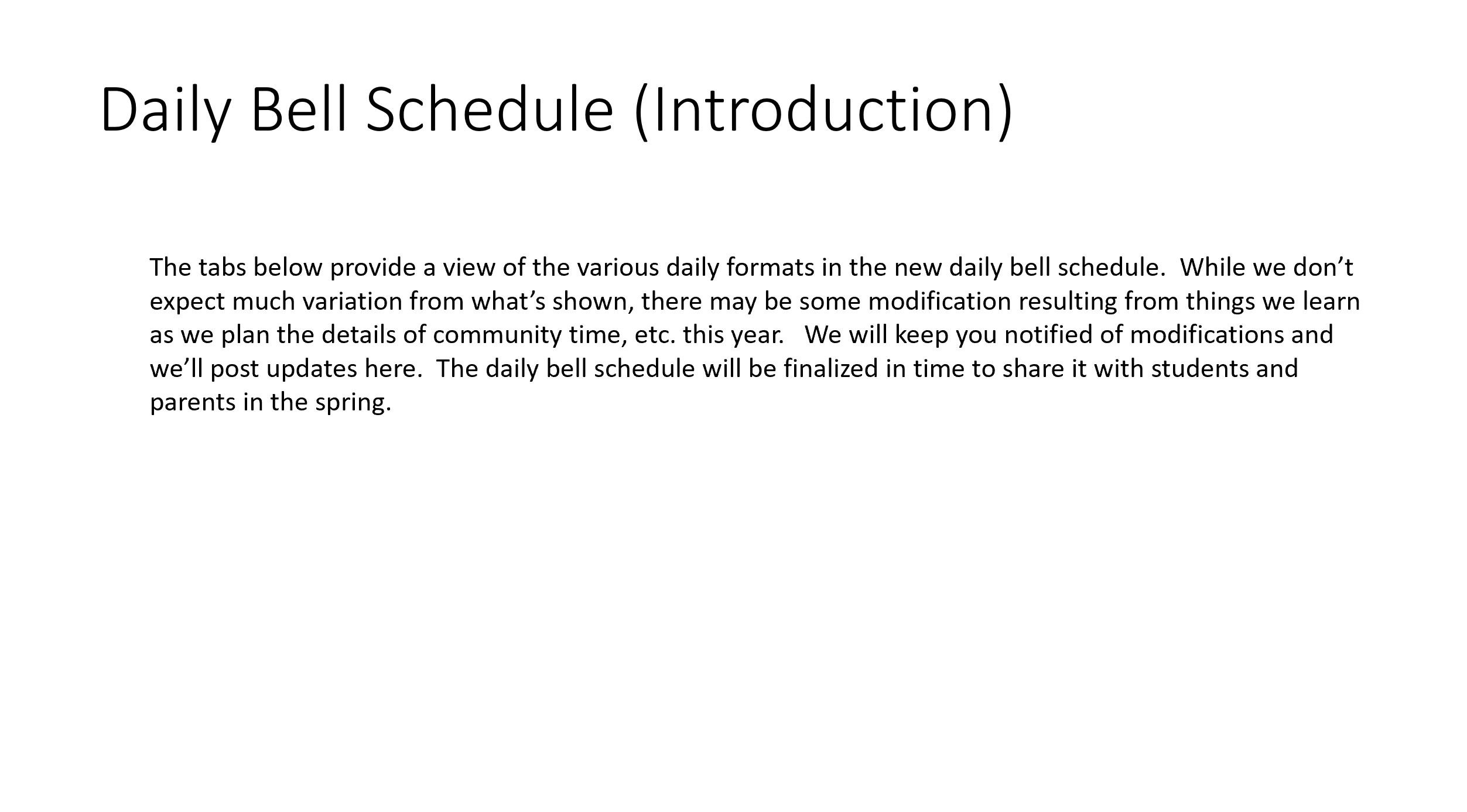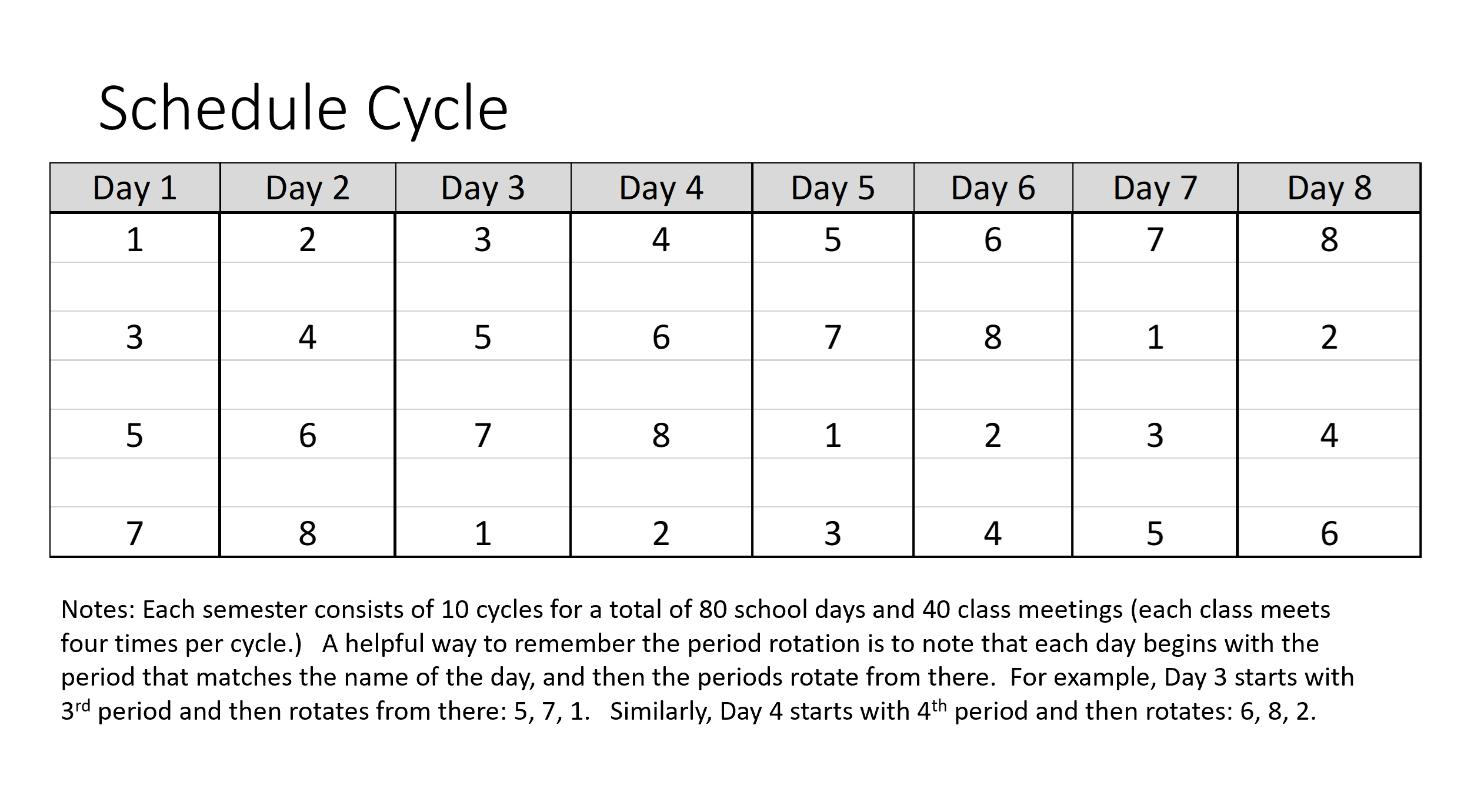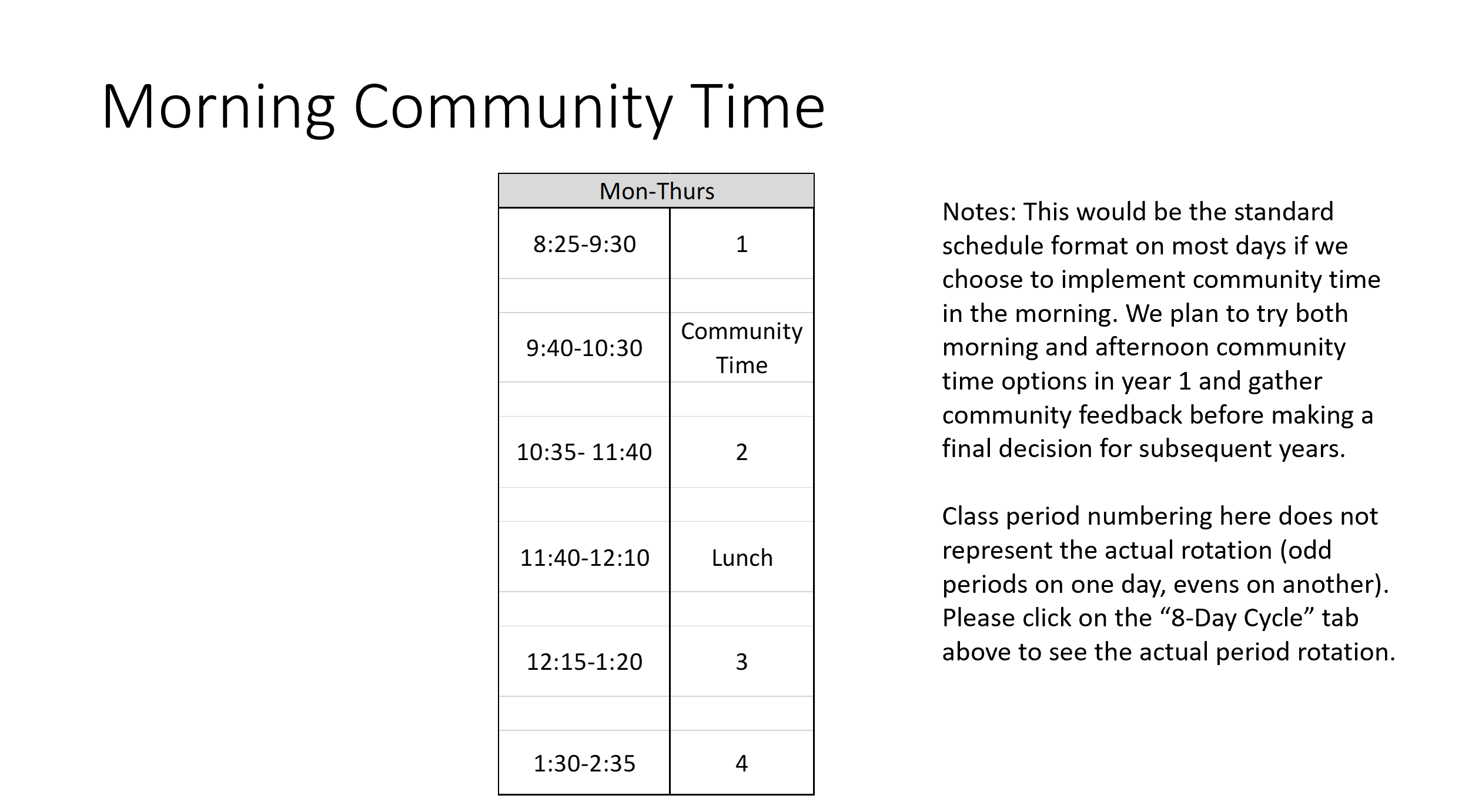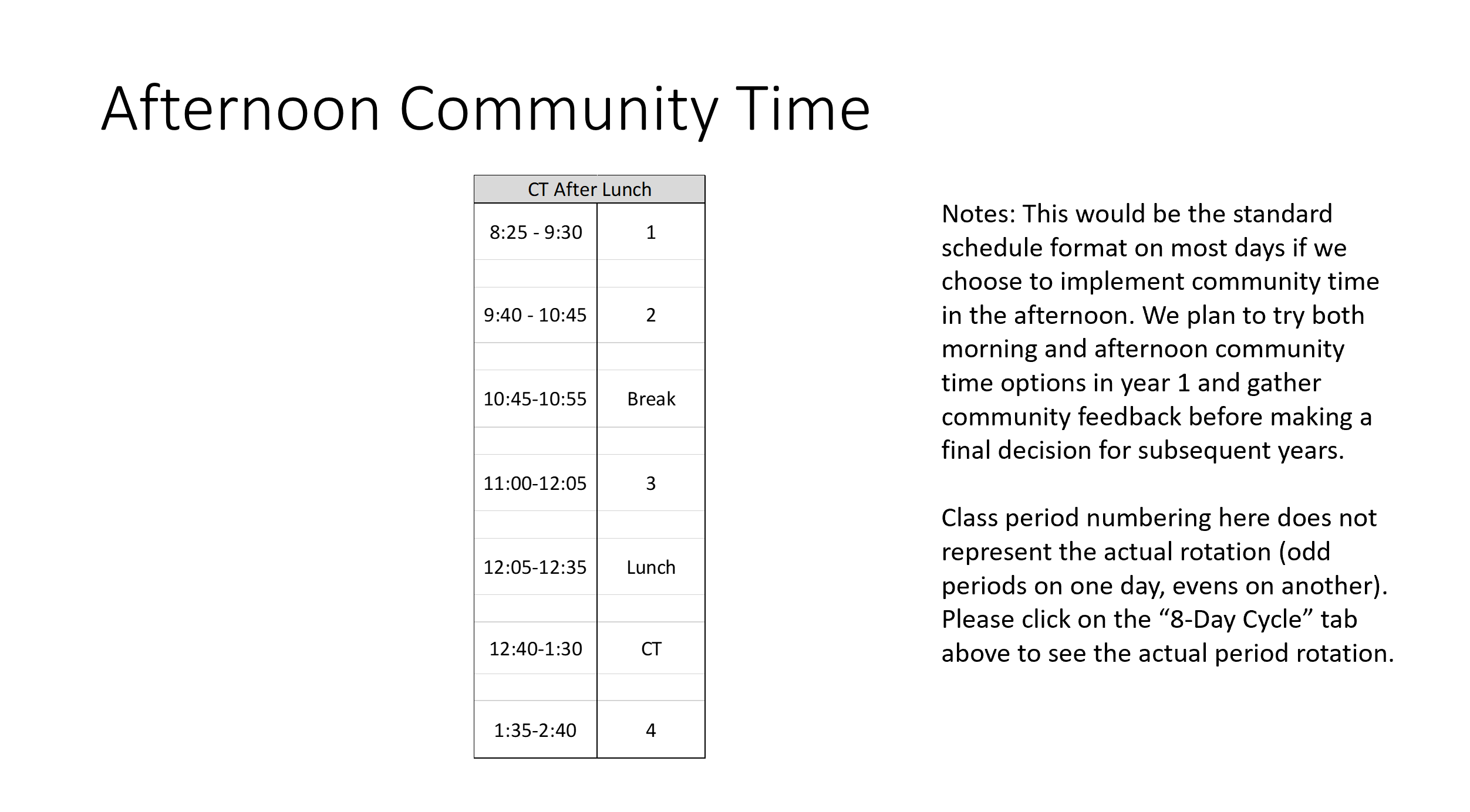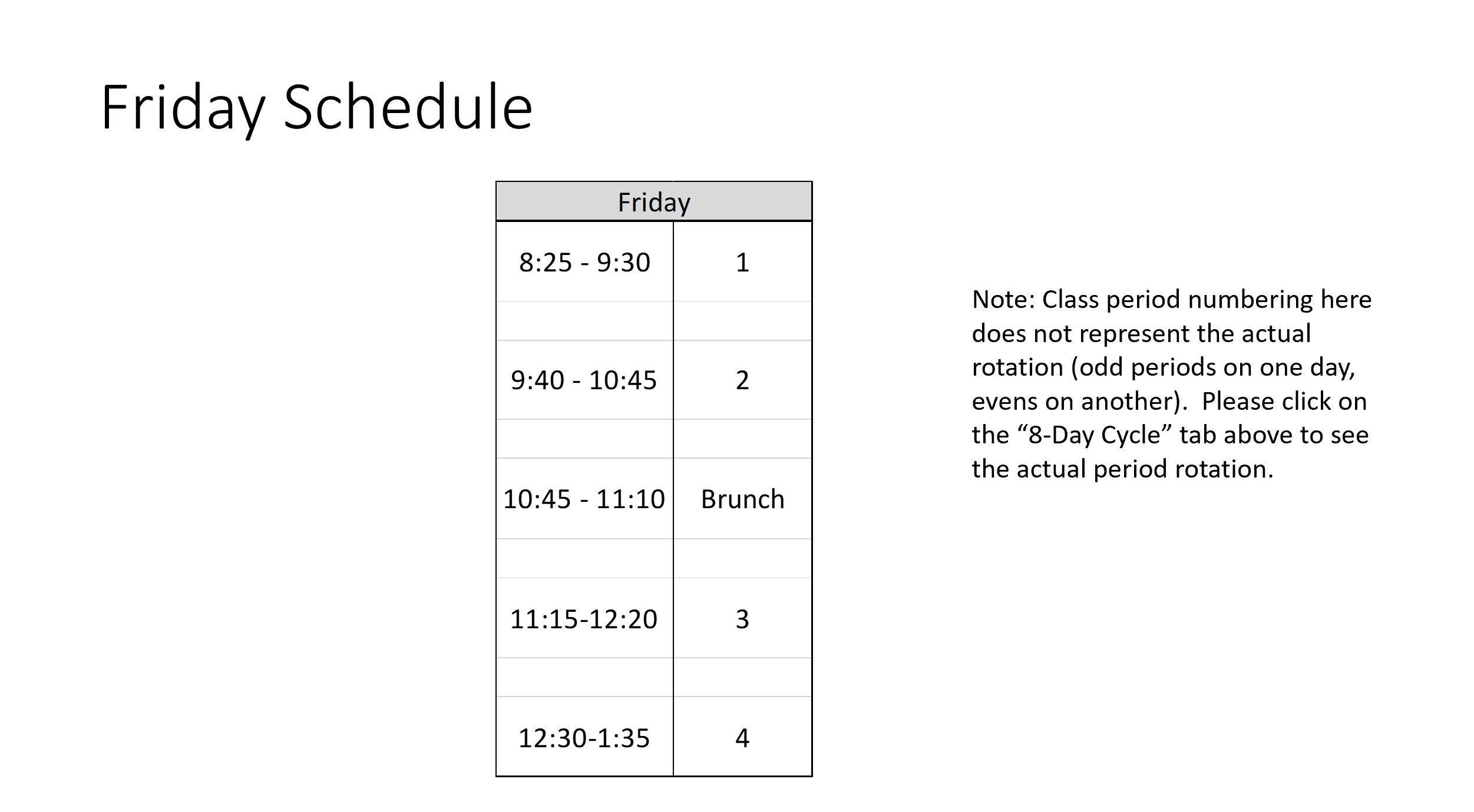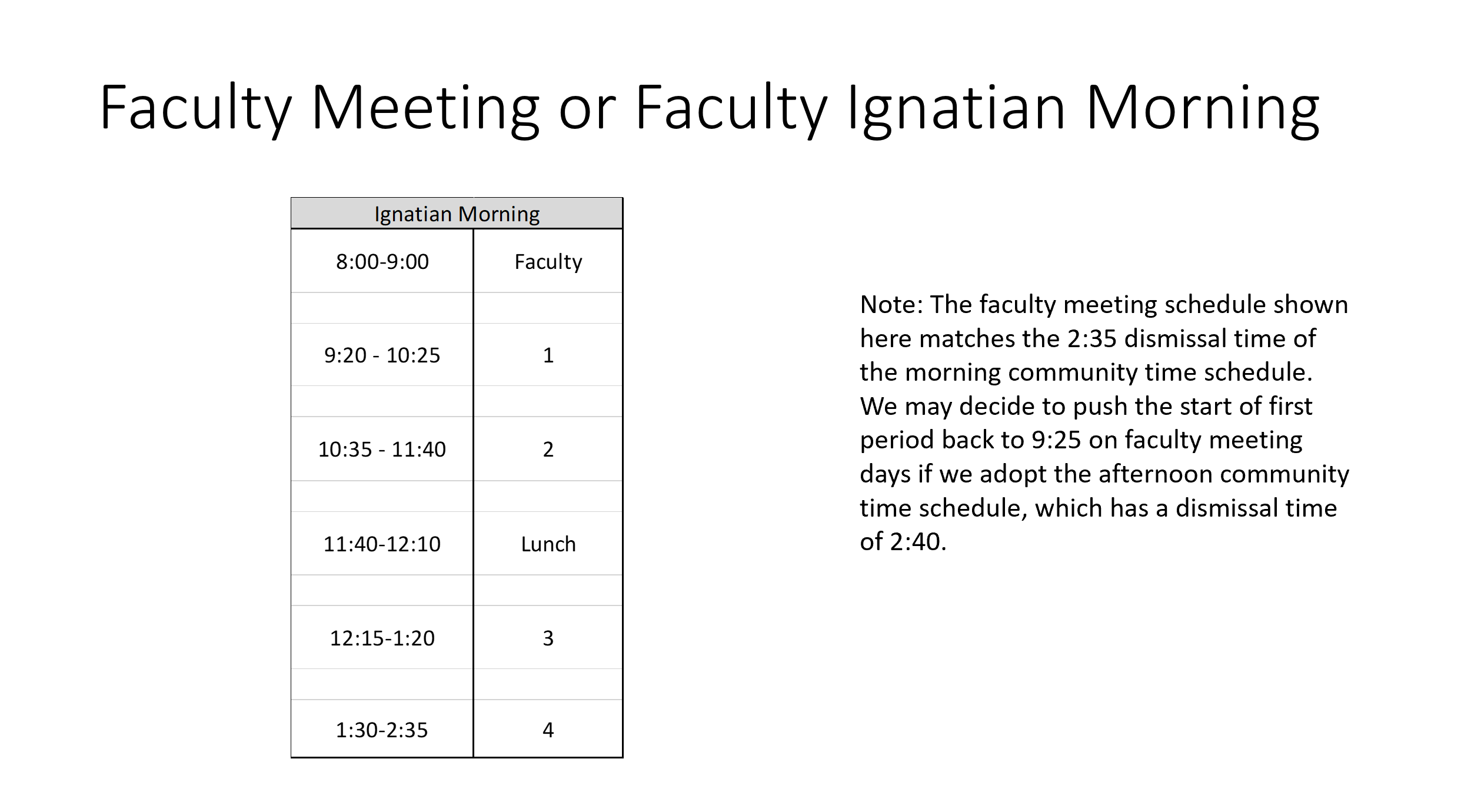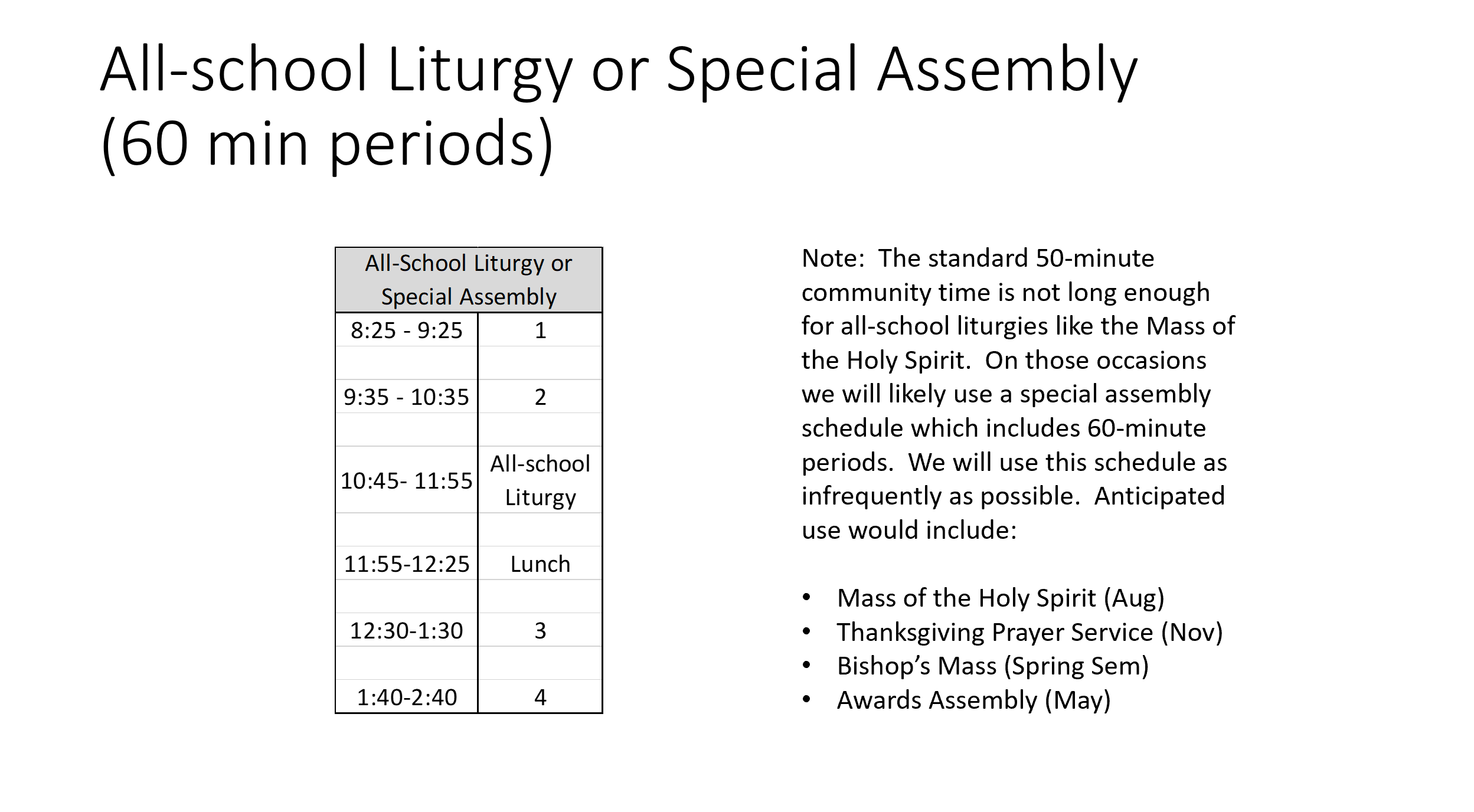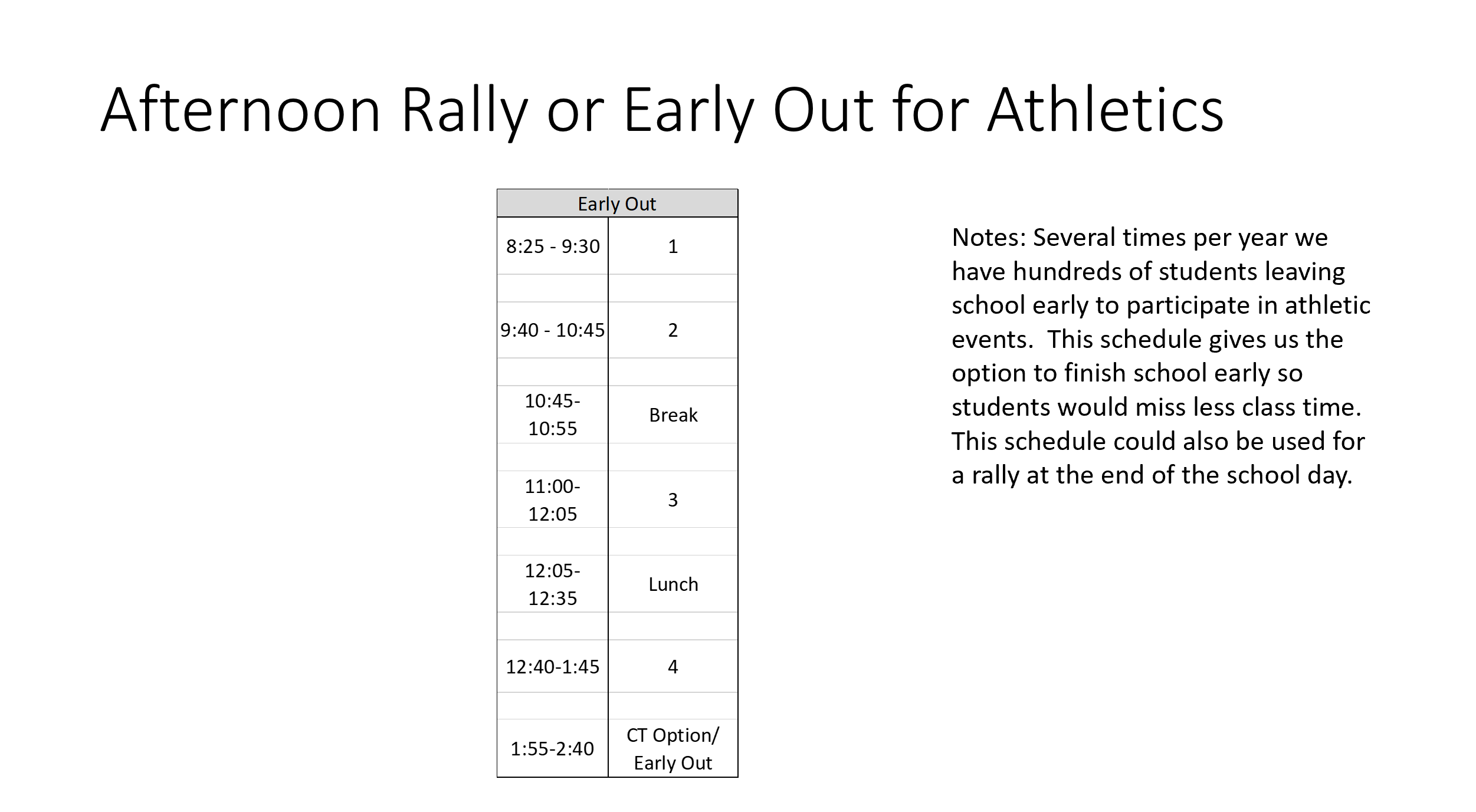| Welcome to the Schedule Transition Web Page. The page serves as a resource for faculty and staff looking for information regarding the planning for the new bell schedule in the 2020-21 academic year. It will be updated periodically with additional content and resources as we continue to plan this year. If you have questions or comments regarding content then please email Dave Barone. |
Course Planning
-
Course Planning FAQ
Q: How much class time are we planning for in the 2020-21 school year?
A: --Semester 1: 40 class meetings, 65-minute periods (2600 minutes)
--Semester 2: 40 class meetings, 65-minute periods (2600 minutes)Comparison with 2019-20 school year:
--Semester 1: 57 class meetings, 50-minute periods (2850 minutes)
--Semester 2: 60 class meetings, 50-minute periods (3000 minutes)Q: What is the plan for final exams?
A: In the fall semester there will not be a final exam week. During the last two weeks of classes there will be designated days on which a department may give a final exam if they wish. The choice to give a final exam is up to the department. Departments may choose to give final exams for some courses but not for others. If a final exam is given for a level course then it must be aligned across all teachers on a level team (content assessed, structure of exam, level of rigor, rubric and grading policy).The schedule committee proposed a similar plan for final exams in the spring semester. While this plan is feasible in the 2020-21 school year, we’ve learned that it would result in a schedule conflict between AP exams and final exams in other years. So we will keep finals week for the spring semester. Both semesters will have 40 class meetings, the spring semester will have an additional week of final exams. Similar to the policy in the fall semester, the decision to give a final exam in the spring semester is up to the discretion of the department.
Q: What transition work do we need to complete by June 1, 2020?
A: To help guide the planning for next year the Academic Council has classified our courses into three types, and identified the following deliverables for each type:- Singleton Courses—Singleton courses are courses taught by only one teacher. A teacher of a singleton course should submit a Course Plan for that course.
- Aligned Level Courses—Level courses are courses taught across more than one teacher (the level team). The level team for an aligned level course should collectively submit a course plan for the course.
- Level Courses Not Yet Aligned—Teachers of level courses that are not yet aligned have a choice of deliverables. The choice stems from the recognition that the horizontal alignment process often requires more than one year of research, discussion, discernment and decision-making. So teachers of an unaligned level course may opt for one of the following:
- If it’s feasible to align by next year then the team should collectively submit a course plan.
- If the team needs more than a year to align then the teachers on the team should submit individual course plans and the team should collectively submit an alignment roadmap
The deliverables above are submitted to the chair for the purpose of departmental review. Course plans and alignment roadmaps should be reviewed and approved by the department by June 1, 2020.
Q; What should a course plan contain?
A: A course plan can take many forms and should be designed according to the needs of the department. But regardless of form, the plan should contain the following elements:- A brief summary of desired course outcomes
- A list of course materials
- A list of topics/units to be covered, along with an estimate of the class days needed to cover each topic/unit
- Desired unit outcomes
- A brief assessment plan for the course (Types of assessment, how many, etc.)
Course plans will be submitted to the chair and then reviewed by the department for vertical alignment. Please note that a course plan is distinguished from actual lesson planning for a course. The course plan should guide lesson planning but it is meant to be an overview document to facilitate conversations regarding horizontal and vertical alignment. A good target length for a course plan is 4 – 6 pages. As an overview document it should be less than 10.
Q: What should an alignment roadmap contain?
A: An alignment roadmap should include the following elements:- Summary of Current Status—Is there any alignment currently between teachers of the same course? Is there common understanding or common ground to leverage as a starting point?
- Year 1 Objectives—What does the level team hope to accomplish in the 20-21 school year? What steps can be taken toward alignment? If there is investigation to be done then what might that involve? What are the questions that need to be answered?
- Year 2+ Objectives—If alignment will take multiple years then what does the timeline look like? What are the major milestones to track progress?
The roadmap document should speak to all the attributes of alignment: learning outcomes, rigor, assessment of learning, and course materials.
Q: Will departments review singleton courses too?
A: Planning for an elective taught by only one teacher will be different from planning a course taught across several teachers (a level course). A level course will require the coordinated planning of a level team, while an individual elective will not. But departments should discuss the content, skills development, and outcomes of all courses to make sure students are prepared and supported as they move through the curriculum, and to make sure the overall curriculum meets the desired student outcomes of the department.Q: How will we track progress during our transition planning? What are the deliverables for teachers and teams during the process?
A: Course plans and alignment roadmaps should be discussed and reviewed by the department by June 1, 2020. To help departments meet that goal, the Academic Council agreed on two status checkpoints that all departments should target in common:- January 2020
- March 2020
Level teams and teachers of singleton electives should report planning status to the department sometime during these months. (Perhaps an early draft of a course plan and/or alignment roadmap.) In each of these two months there is a series of three consecutive Wednesday mornings reserved for department time, which could be used for department review and discussion of status. By the end of the month, the chair will send a summary of this status to Dave and the admin team. These status checks will not only allow the department to check progress, but they will also provide opportunities for vertical alignment discussions.
Q: What is horizontal alignment?
A: Horizontal alignment of a course means there is consistency of student experience across teachers of the same course. Students taking the same course should be working towards the same learning outcomes, they should be challenged by the same level of rigor, and their learning progress should be measured in the same way, regardless of who is teaching the class. It should be noted that “aligned” does not mean “identical” and an important implementation objective of our alignment effort is to leave room for teacher creativity and personal teaching style. (See document on Horizontal Alignment for more detail.)Q: Why is horizontal alignment important?
A: Horizontal alignment offers several important benefits:- Equity for Students--Horizontal alignment brings equity and fairness for students. It ensures that students taking the same course at a school have a similar experience, regardless of which teacher is teaching the course. They are working towards the same learning outcomes, and they are measured in similar ways.
- Student Readiness for the Next Level—When courses are aligned horizontally it’s easier to ensure that all students are prepared to succeed at the next level. It’s also easier to make adjustments for better vertical alignment (e.g. raising the level of rigor or changing curriculum focus at a particular level).
- Building a Community of Learners--Alignment helps us to grow as a community of learners. Course teams not only provide a structure in which to discuss new ideas, they also make it easier for us to support each other as we implement them. Alignment also provides more support for onboarding of new teachers. (See document on Horizontal Alignment for more detail.)
Q: What is vertical alignment?
Vertical alignment is the practice of reviewing curriculum content to make sure the levels are coherent and that they make sense as parts of a whole. Vertical alignment involves two fundamental questions:- Are students well-prepared, in terms of knowledge and skills, for success at the next level?
- Looking across the four-year experience, does the curriculum deliver the outcomes the department desires for our student?
Answers to these questions contain a number of ingredients. Learning standards, where applicable, certainly play an important role. We’re also guided by an informed understanding of the latest research in the field and of what college and career readiness means for our discipline. Additionally, as Ignatian Educators we’re asked to think more broadly about student formation in the context of ideals like Bellarmine’s Intended Student Outcomes (Openness to Growth and Leadership, Religious and Committed to Social Justice, and Intellectually Engaged). The vertical alignment discussion is challenging because it is both very practical (do the pieces of the curriculum fit together?) and very strategic (what do we really want for our students?). But it is also a meaningful challenge that arguably gets to the heart of our creative vision for the department and why we choose to teach at a Jesuit school.
Q: Why are we discussing alignment during a schedule transition?
A: Maintaining the alignment of courses, horizontally and vertically, requires time for teachers to discuss desired student outcomes and how best to achieve them. Carving out time for this discussion has been difficult at Bellarmine because of the structure of our current schedule. Some departments have managed to align despite the schedule but finding time to meet has been a struggle. The new schedule trades some class time in exchange for teacher discussion time in the form of an additional, shared department prep period. We are building collaboration time into the workflow of the week as a resource for departments, so that teachers can be available for each other. This makes coordination and alignment a lot more feasible. Because of the additional planning time the new schedule offers, and because we need to modify our courses anyway in order to fit the new schedule, now is a good time to plan for alignment.Q: What if parts of a course plan aren’t working out next year? Can course plans be modified?
A: The transition to the new schedule represents a learning curve for all of us and it’s about progress, not perfection. We should plan well but the only way to see whether our plan will work is to try it. We should expect to adjust and modify as we teach our courses in the new schedule. Adjusting and improving courses based on experience isn’t new to us; we know it as a hallmark of good teaching. What alignment asks of us is that we stay coordinated and support each other as we learn and modify. -
Horizontal Alignment: Advantages and Attributes
The document posted below—developed by the Academic Council--describes the model of horizontal alignment we are targeting at Bellarmine. It strives to achieve the goals of alignment while also leaving room for teacher autonomy and creativity. Implementations of horizontal alignment may vary by department and even by level team but they all should be characterized by a common understanding of learning outcomes, level of rigor, and measurement of learning.
-
Example Course Plan Templates
Examples of course plan templates are posted below. Please note that these are offered as examples and there are many ways to structure a course plan. Teachers and level teams should choose a structure that makes the most sense for them and for their department. Most course plans are typically 3-6 pages in length so they are intended as course summary documents and not as detailed lesson planning tools. A course plan should include the following elements:
- Desired Course Outcomes
- Course Materials
- Topics/Units Covered and Time per Topic
- Desired Unit Outcomes
- Assessment/Measurement of Learning
Community Time Planning
-
Community Time List of Questions
One of the objectives of the Community Time Planning Committee is to gather questions from the community regarding the logistics and policies surrounding community time. For example: “On what days will we hold intramurals?” “Will we restrict activities in the week leading up to finals?,” “How might we use community time for make-up exams?” etc. Some of the questions will go to the administration, some will go to the Academic Council, and some may go elsewhere. The committee will discuss some of the questions, do research, and make recommendations as needed. The primary goal is to uncover as many questions and concerns as we can so that we can factor them into our planning. Please feel free to send committee members any community time questions you may have. We will document and share questions and answers as they are gathered so that faculty and staff can review them and provide feedback. The pdf document below will be updated periodically as we have more information to share.
-
Community Time Committee Meeting Minutes
The Community Time Planning Committee meets every other week to discuss questions related to help structure next year’s academic calendar and to identify and discuss questions related to the logistics and policies of community time. Meeting minutes will be posted here. The minutes of the first meeting (9/11/19) provide more detail regarding the objectives of the committee.
Draft 2020-2021 Calendar
-
(Coming January 2020)
(Coming January 2020)
Schedule Structure
Resources
-
Article: “What’s the Purpose of Final Exams?
In this article, college professor Kevin Gannon investigates a range of approaches to final assessment, from the traditional final exam, to a capstone finale experience. In the process he finds that intentionality is essential to an effective and meaningful course ending.
-
Article: “How Relearning Old Concepts Alongside New Ones Makes It All Stick” (Homework Strategy)
In this article several researchers explain the learning benefits of “interleaving” old and new topics and skills as a homework strategy, and why interleaving is a more effective teaching strategy than “block practice” (lots of repetitive drilling of the same skill or content). They also explain that most people don’t recognize interleaving as more effective because it involves more struggle and it takes more time. Block practice feels better because a specific topic is learned quickly, but retention and the quality of learning is poor. A more detailed discussion of this topic can be found in the book Range: Why Generalists Triumph in a Specialized World, by David Epstein (2019).
Faculty Workshop Information
-
Better Conversations (September 23-24, 2019)
Facilitator: Ann Hoffman, Instructional Coaching Group
Description:
As we plan the transition to the new schedule, there will be a need for conversations within departments and level-teams regarding curriculum and instructions: pruning and prioritizing curriculum, course alignment, and exploring new instructional and curricular ideas. The path forward will require us to become more team-like in the way we make decisions, work together, and support each other. The Better Conversations Workshop will give us an opportunity to look at a set of core beliefs (including autonomy) which can form the foundation for habits of communication that will not only support us through the transition, but also bring us closer as a learning community. This in turn opens us to the idea of freedom within form, and the view of a team not as a constraint on our autonomy, but as a source of professional and personal support, and a resource to leverage when exploring and implementing creative ideas.
Based on the book, Better Conversations, this workshop describes essential communication skills for everyone in a school to help create a setting where learning will flourish. It provides a framework for discussing what we value as professionals, and the communication practices that support those values and help to connect us.
-
Grading Smarter, Not Harder (January 7, 2020)
Facilitator: Myron Dueck, Teacher and Author, Grading Smarter Not Harder
Description:
With a 10% decrease in overall class minutes, and fewer class meetings, the new schedule calls for a look at curriculum and instructional practices. By extension, this also means reviewing our practices regarding homework and assessment. Myron Dueck’s thought-provoking book, Grading Smarter Not Harder, calls into question long-standing assumptions regarding homework, assessment, and grading practices. It offers alternative strategies, supported by research and Dueck’s own practice as a history teacher, which help to make homework and assessment more meaningful activities. Based on ideas in the book, the math department has implemented several changes to homework policy, grading rubrics, unit plans, and assessment for learning. These changes have not only helped to inform our teaching practices, but they have also helped to motivate students and help them learn. The Grading Smarter Not Harder workshop will provide an opportunity for us to hear these ideas directly from the author and to discuss them together.
-
High Impact Instruction (March 16-17, 2020)
Facilitator: Ann Hoffman, Instructional Coaching Group
Description:
Based on the book, High-Impact Instruction, by Jim Knight, this workshop presents a collection of high-yield techniques related to:
- Course planning
- Formative assessment
- Instructional practices
- Building community in the classroom
Some of the techniques may be familiar, some new, but they all have been identified by the Instructional Coaching Group as “high-impact,” meaning they deliver a very high return in terms of student learning and engagement, for a reasonable (and sustainable) teacher/team effort. The book itself, and the instructional playbook that can be developed from it, are both excellent resources for departments, level-teams, and teachers to turn to for ideas to try during the schedule transition and beyond. Unlike a one-size-fits-all approach, High-Impact Instruction provides a flexible framework for exploring high-leverage instructional practices that a teacher can customize to fit his/her working style and students’ needs.
